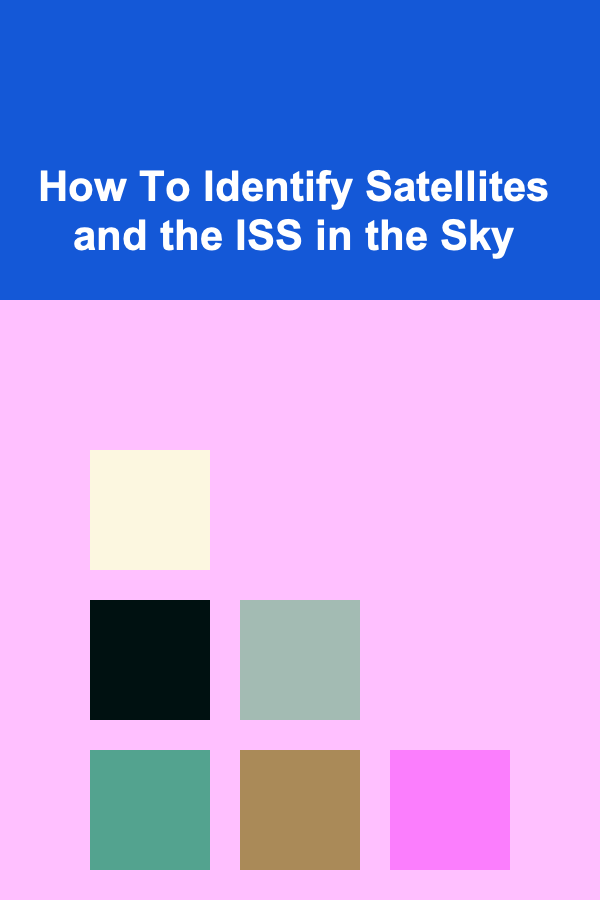
How To Identify Satellites and the ISS in the Sky
ebook include PDF & Audio bundle (Micro Guide)
$12.99$9.99
Limited Time Offer! Order within the next:

Introduction
The night sky is filled with thousands of celestial objects, ranging from stars and planets to artificial satellites and space stations. Among these, satellites and the International Space Station (ISS) stand out as some of the most visible and fascinating objects you can spot with the naked eye. While many people are familiar with the ISS due to its prominence in space exploration, the vast majority of artificial satellites in Earth's orbit remain unknown to the general public. This article will explore the methods and techniques used to identify satellites and the ISS in the sky, providing you with the knowledge and tools to spot these human-made wonders as they orbit our planet.
What Are Satellites?
Before we dive into identification techniques, it's essential to understand what satellites are and their function in Earth's orbit. Satellites are any objects that are placed into orbit around Earth, including both natural and artificial ones. Natural satellites, like the Moon, have been in orbit for millions of years. However, when we refer to "satellites" in this context, we typically mean artificial ones---objects launched by humans into orbit for various purposes, such as communication, weather monitoring, and scientific research.
What Is the International Space Station (ISS)?
The International Space Station is an enormous space laboratory that orbits Earth at an average altitude of approximately 400 kilometers (about 248 miles). The ISS is not a typical satellite---it is a collaborative effort between various space agencies, including NASA, Roscosmos, ESA, JAXA, and CSA. It serves as a hub for scientific research in microgravity, allowing astronauts from different countries to conduct experiments in various fields, including biology, physics, and astronomy.
While the ISS is technically a satellite, its large size, unique structure, and regular human presence make it a distinct object to spot in the sky. Unlike other satellites, the ISS can be easily observed without a telescope, often appearing as a bright moving light across the sky.
Why Are Satellites and the ISS Visible in the Sky?
Satellites, including the ISS, are visible because they reflect sunlight. The Earth's atmosphere scatters light in various directions, but once a satellite is above the atmosphere, it is exposed to direct sunlight. This sunlight bounces off the satellite, making it visible to observers on the ground. The ISS, due to its large size and reflective solar panels, is especially bright and can often be seen at dawn or dusk when the satellite is illuminated by the Sun but the observer's location is in the Earth's shadow.
Factors That Affect Visibility
Several factors can affect whether or not you are able to see satellites or the ISS in the sky:
- Time of Day: The best time to spot satellites is during dawn or dusk, as this is when the satellites are illuminated by the Sun but the observer's location is in darkness.
- Altitude: Satellites in low Earth orbit (LEO), such as the ISS, are usually the easiest to spot. Higher altitude satellites are more difficult to observe with the naked eye.
- Weather Conditions: Cloud cover, pollution, and light pollution from urban areas can make it difficult to spot satellites. Clear, dark skies away from artificial lights offer the best visibility.
- Satellite Size: The larger the satellite, the easier it is to spot. The ISS, being one of the largest human-made objects in orbit, is exceptionally bright and visible from the ground.
- Orbital Path: Different satellites and the ISS follow different orbits, meaning that their positions in the sky change over time. Some orbits pass over specific regions at certain times, making the satellite visible only in those areas.
How to Identify Satellites and the ISS
Identifying satellites and the ISS in the night sky requires a keen eye and some basic knowledge of their appearance and movement. Here's a step-by-step guide to help you recognize these fascinating objects.
1. Look for a Steady, Moving Light
The most distinct feature of a satellite or the ISS is the steady motion of the light across the sky. Unlike airplanes or stars, which may twinkle, satellites shine with a constant, non-flashing light. The ISS, being particularly bright, often outshines most stars and may appear to move more slowly or rapidly depending on your location and the satellite's orbit.
2. Track the Direction of Movement
Satellites generally move in a west-to-east direction due to the Earth's rotation and the orientation of their orbits. The ISS is no exception, and its path across the sky can often be seen from the western horizon to the eastern horizon. While satellites can follow different orbital paths, most of them, including the ISS, will follow a similar trajectory.
3. Use Satellite Tracking Apps
One of the easiest ways to identify satellites and the ISS is to use satellite tracking apps and websites. There are several free tools that allow you to track the position and movement of satellites in real time. Some of the most popular satellite tracking apps include:
- Heavens-Above: This website provides detailed sky charts that allow you to track satellites, the ISS, and other space objects. Heavens-Above also provides exact times for when the ISS or a satellite will pass over your location.
- SkySafari: SkySafari is a mobile app that allows users to track celestial objects, including satellites and the ISS, and gives information on their current position, visibility, and trajectory.
- ISS Tracker: Dedicated apps for the ISS, such as ISS Tracker, allow you to receive real-time notifications and visual maps showing the exact location of the ISS above Earth.
These tools provide exact timings for when satellites will be visible from your location, taking the guesswork out of satellite spotting.
4. Check for Brightness and Size
The ISS is one of the brightest objects in the sky due to its large surface area and reflective solar panels. When you see a bright moving object, particularly at dawn or dusk, it is likely the ISS. It is much brighter than most stars and can often be seen from cities with light pollution. Other satellites, while still visible, tend to be fainter and can vary in brightness depending on their size and materials.
5. Understand the Different Types of Satellites
There are thousands of satellites orbiting Earth, each serving different purposes. Some are easy to spot, while others are harder to detect. Here's a brief overview of the different types of satellites you might observe:
- Communication Satellites: These are the most common types of satellites. They are typically small and are often placed in geostationary orbits. Due to their high altitude, these satellites are generally not visible with the naked eye.
- Earth Observation Satellites: Used for weather monitoring, mapping, and surveillance, these satellites can be in low Earth orbit (LEO), which makes them visible from Earth at certain times.
- Navigation Satellites: These satellites are part of systems like GPS and Galileo. They are primarily designed for communication with ground-based receivers and can sometimes be visible in the sky.
6. Watch for ISS Flashes
The ISS can sometimes be seen flashing as it rotates and reflects sunlight from different angles. These flashes may appear as quick, bright bursts of light, and this phenomenon is commonly referred to as the "flare" effect. The ISS is the most likely satellite to produce these flashes, making it easier to distinguish it from other, fainter satellites.
7. Look for Satellite Constellations
In recent years, satellite constellations like SpaceX's Starlink have become more prevalent. These constellations consist of hundreds or even thousands of satellites working together to provide global internet coverage. These satellites are typically smaller than the ISS but are visible in groups, often forming a "train" of bright lights moving across the sky in quick succession. If you see a series of lights traveling together in a straight line, it's likely a satellite constellation.
Conclusion
Identifying satellites and the ISS in the sky can be a thrilling and rewarding experience. With the right knowledge, tools, and a little practice, you can easily spot these human-made marvels as they orbit our planet. By paying attention to their unique movement patterns, brightness, and using tracking apps, you'll be well-equipped to observe these fascinating objects in the night sky.
The next time you're outside on a clear evening, take a moment to look up---chances are, you'll spot a satellite or the ISS making its way across the heavens, a testament to the incredible achievements of space exploration.

How to Build Relationships with Peers in a Virtual Setting
Read More
How to Get Creative with Your Yard Sale Marketing Strategy
Read More
How to Incorporate Vintage Decor into Your Home on a Budget
Read More
How to Soundproof a Child's Room for Quieter Play
Read More
How to Store Seasonal Decor Without Taking Up Too Much Space
Read More
How To Find Books That Lead to Great Conversations
Read MoreOther Products

How to Build Relationships with Peers in a Virtual Setting
Read More
How to Get Creative with Your Yard Sale Marketing Strategy
Read More
How to Incorporate Vintage Decor into Your Home on a Budget
Read More
How to Soundproof a Child's Room for Quieter Play
Read More
How to Store Seasonal Decor Without Taking Up Too Much Space
Read More